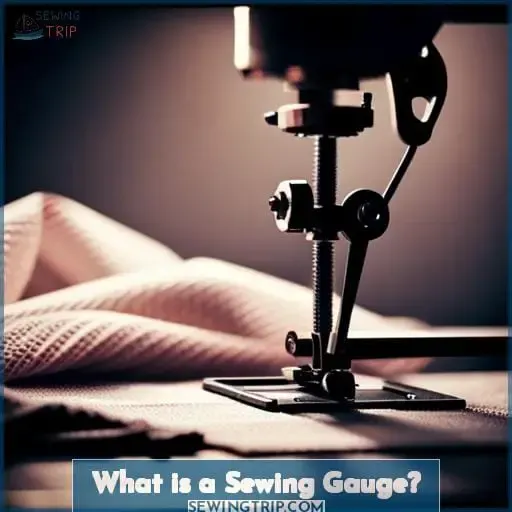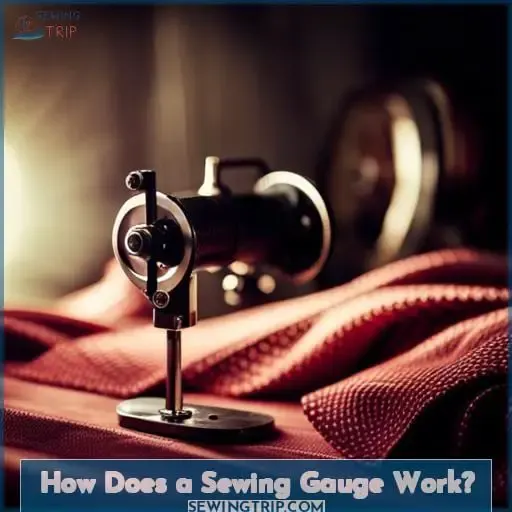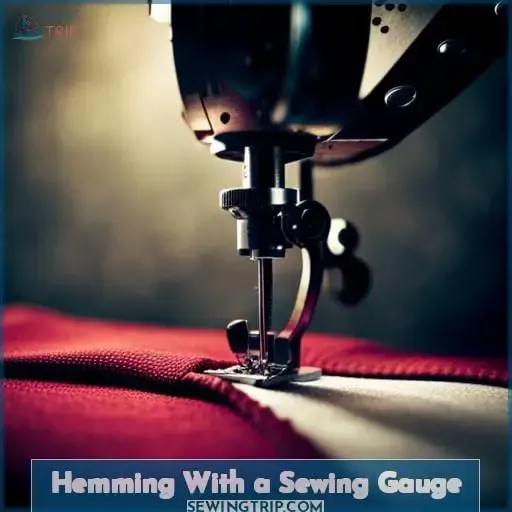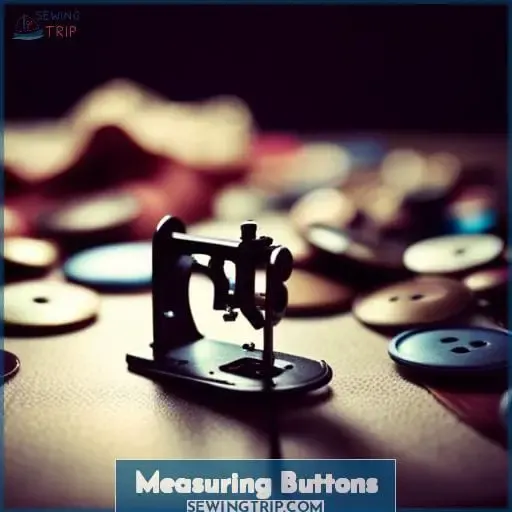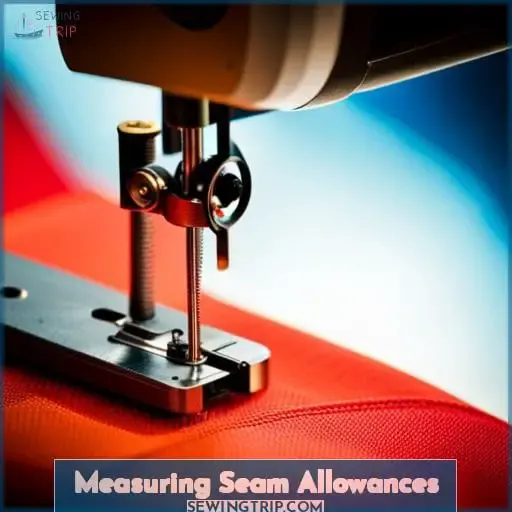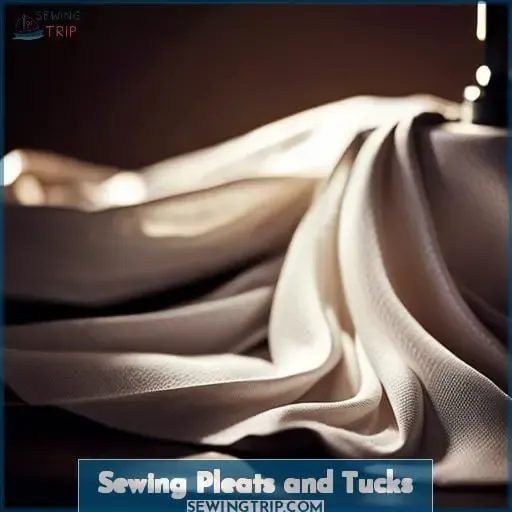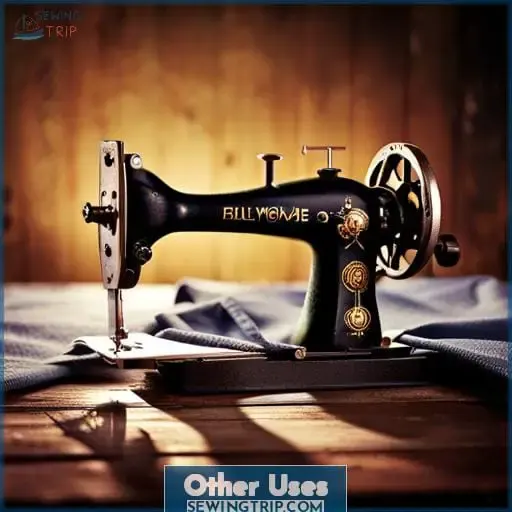This site is supported by our readers. We may earn a commission, at no cost to you, if you purchase through links.
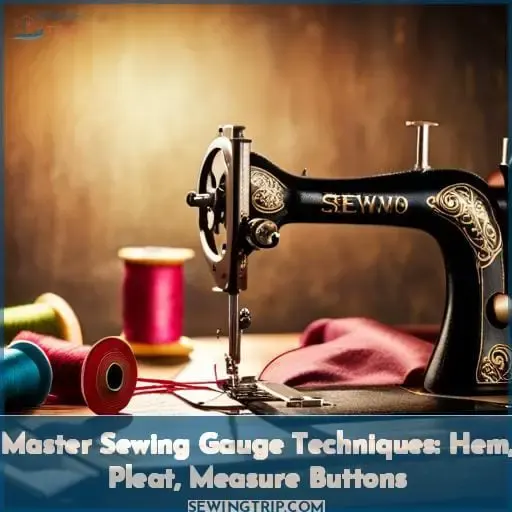 Like a guiding light in the darkness, a sewing gauge illuminates the path to perfect hems, pleats, and button placements.
Like a guiding light in the darkness, a sewing gauge illuminates the path to perfect hems, pleats, and button placements.
This indispensable tool transforms you from a novice stitcher into a master craftsman, empowering you to create garments that are both beautiful and functional.
With its precise markings and intuitive design, the sewing gauge becomes an extension of your hand, allowing you to work with confidence and accuracy.
Table Of Contents
Key Takeaways
- Line up slider with fabric edge to precisely measure hem width, seam allowances, buttonholes, and more
- Adjust slider to desired measurement markings for consistent sizing of hems, pleats, tucks, and other features
- Use inch and centimeter markings for functionality with metric or standard measurements
- Check buttonhole spacing by measuring diameter and distance between buttons
What is a Sewing Gauge?
You’re looking at a 6-inch ruler with a slider for accurate measuring.
This versatile tool allows for precise measurements down to 1/8th of an inch, enabling accurate hems, perfectly spaced buttons, and evenly sized pleats.
The wider slider stabilizes against the fabric edge while measuring, preventing slippage.
Whether hemming trousers or a skirt, spacing shirt buttons, or perfectly sizing intricate tucks on a formal gown, this gadget helps master flawless finishing techniques.
Simply set the slider to the desired width, align the gauge’s edge parallel to the fabric edge, and fold.
The gauge ensures uniform allowances for professional results.
With some practice, you’ll expertly measure hems, pleats, buttons, and beyond.
How Does a Sewing Gauge Work?
With your sewing gauge, the slider in the middle allows for accurate measuring while resting right on the edge of the fabric to stabilize it.
The slider mechanism is wider than the sewing gauge body. This allows it to straddle the fabric edge for support.
The result is measurement precision within 1/8th inch increments.
Having both inch and centimeter units maximizes functionality.
For hemming, first determine the desired width.
Then fold the fabric over that distance.
Finally, align the gauge slider edge with the fabric edge.
Adjust until the raw fabric edge meets the gauge ruler end.
Your hem is now perfectly measured for even turning and pressing.
With these tips, utilize your gauge fully when hemming or measuring buttons, bias tape, pleats, and more.
Hemming With a Sewing Gauge
For the first method:
- Fold the fabric edge to the desired width, wrong sides together.
- Line up the slider with the folded edge and adjust it so the raw edge aligns with the end.
For the second method:
- Make two turns – one narrow, one wider to hide the raw edge.
- Sew close to the fold.
Method 1
Lay the fabric wrong side up.
Determine the hem’s width.
Move the slider to that measurement.
Fold the fabric edge to the desired width with wrong sides together.
Line up the slider with the folded edge.
Adjust the turned edge so the raw edge of the fabric is lined up with the end of the sewing gauge for hemming precision.
The slider’s width stabilizes the gauge on the fabric edge while aligning the fold for accurate hem depth.
Use the sewing gauge’s measurements for precise buttonhole sizing and seam allowances too.
Method 2
Turn the fabric edge and measure it twice: once for a narrow bit and again to hide the raw edge.
Make the first turn, usually between 1/4 to 1/2 an inch, and press.
Make the second turn to hide the narrow bit and the raw edge of the fabric, and press.
Sew along the edge of the narrow bit close to the fold to ensure the raw edge stays hidden.
Measuring Buttons
You can use the sewing gauge to precisely measure button diameters and spacing when sewing on buttons.
Slide the marker along the edge to determine the exact size of each buttonhole.
Ensure even spacing between buttons by measuring the distance between button placement marks with the sewing gauge.
For evenly sized buttons, space the same length apart.
For varying sizes, allow slightly more space between larger buttons.
Use an air- or water-soluble fabric marker to accurately mark your fabric.
When stitching the buttonholes, reference the gauge to double check sizing.
For accuracy, carefully line up the gauge with each buttonhole marking before sewing.
Precise measurement with the sewing gauge results in professional buttonholes at the perfect size for your buttons.
Measuring Seam Allowances
You’re able to precisely measure seam allowances with the sewing gauge by lining up the edge of the fabric with the markings.
Pinning techniques such as using silk pins for finer fabrics or curved safety pins for thicker materials allow you to temporarily hold the fabric layers together.
Precision tips like consistently lining up the same side of the gauge and fabric edge each time ensures uniformity.
Troubleshooting uneven seam allowances may require repositioning your hands or the angle of the gauge.
Creative applications could include measuring tucks, pleats, casings, or trim distances too.
Consider lighter gauge materials when measuring tightly to prevent distortion.
With practice, you’ll master exact seam allowances for professional results.
The handy sewing gauge empowers perfect measuring whether for basic hems or custom seam allowances.
Sewing Pleats and Tucks
One can accurately measure and sew pleats and tucks with a sewing gauge.
Start by determining the width between pleats or depth of the tucks.
Adjust the slider on the gauge to the desired measurement.
Mark the fabric at the top edge where the pleats or tucks should begin.
Make a second mark down from the top edge to indicate the fold line.
Use different colored fabric markers to differentiate the two lines.
Pin the fabric at the marks to hold the folds in place.
Carefully sew the pleats or tucks, using the gauge to double check measurements.
The gauge ensures uniform pleats and tidy tucks for a professional finish.
With practice, a sewing gauge brings pleat precision and tuck techniques for creative folds.
Other Uses
The utility of a sewing gauge extends beyond hemming, tucking, and measuring buttons.
When sewing bias binding, utilize the gauge to fold the binding fabric precisely at 1/4 inch.
Mark buttonhole placement on the button band, measuring the distance between holes accurately.
The gauge helps mark starting and stopping points when sewing long seams. Make distinctive markings with fabric pens to indicate where to start and stop sewing.
When hemming, the gauge ensures exact hem width.
Creating bias binding, the gauge helps fold the binding fabric correctly before finishing the edge with zig-zag stitching.
The humble sewing gauge supports precision sewing in countless ways.
Frequently Asked Questions (FAQs)
How do I clean and care for my sewing gauge?
Always wipe your sewing gauge clean after each use.
Use a barely-damp cloth to gently remove fabric fuzz and lint.
Allow to fully air dry before storing.
Periodically check for damage and smooth operation of the slider.
Replace if bent or damaged.
Gentle care keeps it working smoothly for precise measuring.
My sewing gauge slider is stuck – how can I fix it?
Gently tap it with a small hammer to loosen.
Then lubricate with sewing machine oil.
Wiggle it back and forth to free it up.
Avoid forcing it.
What’s the best way to store a sewing gauge?
Keep your sewing gauge in a protective sleeve or pouch when not in use.
Store it flat to avoid warping.
Never toss it loosely in a box or drawer.
Proper storage keeps it clean and undamaged for accurate measuring every time.
Can I use a sewing gauge on knitted or stretchy fabrics?
Yes, you can use a sewing gauge on knitted or stretchy fabrics.
Place it gently against the fabric.
Move slowly.
Use pins to hold it in position.
Handle it carefully to avoid distorting the knit.
Check measurements frequently.
Are sewing gauges safe to use with children/beginners?
Yes, sewing gauges are safe for children and beginners to use under supervision.
Guide them to hold the tool properly and make simple measurements.
With practice, a sewing gauge helps develop fine motor skills and understanding of fractions.
Take care not to let young kids play with them unwatched as the metal edges could cause harm if handled roughly.
Conclusion
Like a lighthouse guiding sailors through stormy seas, the humble sewing gauge will steer you towards sewing success.
With practice, its markings will illuminate the path to precise hems, buttons, and pleats.
Let this tool become an extension of your hand, empowering you to create garments with confidence.
Master the sewing gauge, and your creations will shine with the radiance of perfection.

